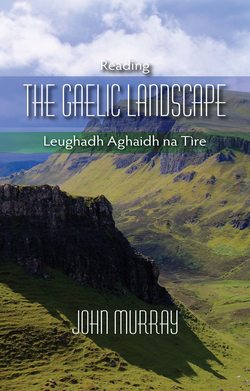Читать книгу Reading the Gaelic Landscape - John Murray - Страница 7
На сайте Литреса книга снята с продажи.
ОглавлениеPreface to Second Edition
Though place-names are usually unchanging, their study always changes. After four years, a revision was due. Some photographs and drawings have been improved. Some new ones have been added. All photographs are now in colour. The text has been redrafted. Amongst many additions, especially to the chapter on grammar and pronunciation, there are examples of how Gaelic personal names and the human body are used in place-names, with a new diagram. There is another new drawing analysing Gaelic valley form. I have modified my thinking about the Glen Dochart topomnemonic or songline, which now has a map. And I have found the real reason behind Allt a’ Bhealach Gliogarsnaiche - Burn of the Tinkling Pass, in Glen Vorlich. Some etymological sources have been added to place-name tables as well as some proverbs to chapter and subject headings. There is more to say about hares, bears and boars.
Preface to First Edition
Fishing below Quinag or A’ Chuinneag – The Milking Pail (NC203283) in Sutherland, I met an English angler. Pointing west into the heart of the mountain (plates 2 & 27), he said that he had given up fishing at the black loch, since gusts of wind in the corrie made casting impossible. I said: ‘But the black loch lies to the east, on the other side of the glen on Glas Bheinn - Grey Mountain (NO254265)? What the fisherman wrongly named was Lochan Bealach a’(n) C[h]òrnaidh - Lochan of the Pass of Cloth Folding (NO207282). Two thoughts came to mind. My fellow angler was not sure where large features were in the landscape, since he could neither read nor understand what was mapped. This prompted him to invent his own private place-name in English. He then confused his name with Gaelic ones on the map.
Plate 2: A’ Chuinneag - Sàil Gharbh, Bealach Cuinneige and Sàil Ghorm
Later that week on a visit to a shop near Drumbeg or An Druim Beag - The Small Ridge (NO125267 ), I noticed a sign at a road end saying that the family had stayed on the croft for over 150 years. I talked with the owner about the walk we had just enjoyed. I told her we had passed Poll nam Muc or Pool of the Pigs (NO123315) and Loch Bad an Òig [na h-Òige] or Loch of the Place of the Young (NO117314), and how these names must speak of a forgotten past. But the owner replied that she had neither heard nor understood them. Though the first language of her parents had been Gaelic, they never spoke it to their daughter. Despite 150 years of family history rooted in one place, she had lost touch with the landscape described by the language of her mother and father. Her shop sign had lost a lot of its substance.
In these two encounters, both an insider and an outsider to the landscape showed that they did not know about the richness recorded in place-names. These brief conversations persuaded me to write this book.
